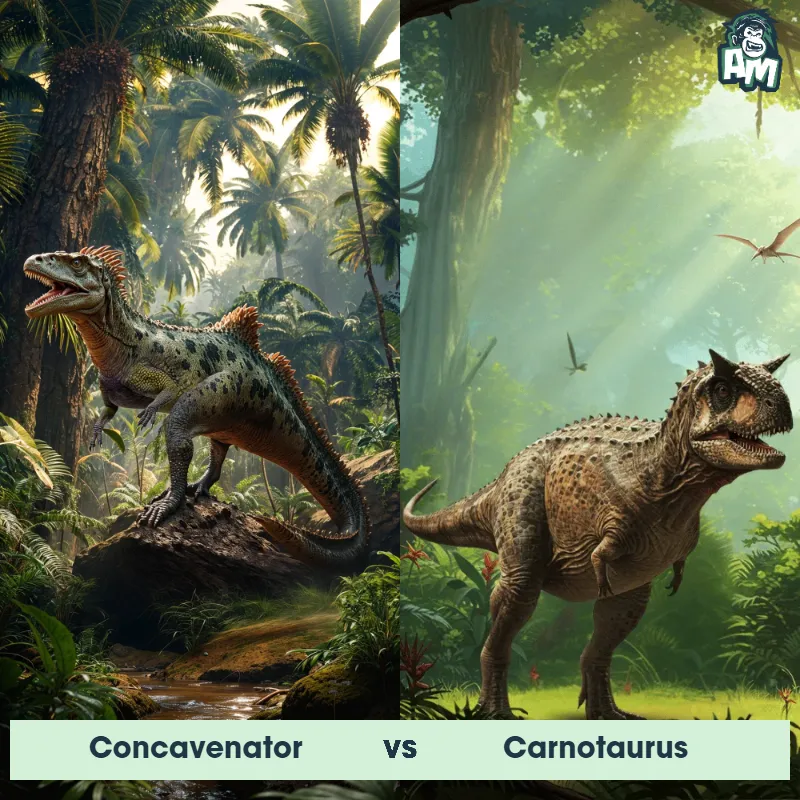The Concavenator
The Concavenator, also known as the "humped hunter," was a theropod dinosaur that lived during the Early Cretaceous period. It was about 20 feet long, with a distinct hump on its back formed by elongated neural spines. This carnivorous dinosaur had short arms with two fingers on each hand and sharp teeth for hunting.

| Concavenator | |
|---|---|
| Size | 20 feet (6 meters) |
| Weight | 2 tons (1,814 kilograms) |
| Speed | 20-25mph (32-40 km/h) |
| Key Strength | Powerful jaws and claws |
| Biggest Weakness | Limited agility |
| Scientific Name | Concavenator corcovatus |
| Family | Carcharodontosauridae |
| Habitat | Terrestrial |
| Geography | Spain |
| Diet | Carnivorous |
| Lifespan | 20 years - 25 years |

The Concavenator
The Concavenator, also known as the "humped hunter," was a theropod dinosaur that lived during the Early Cretaceous period. It was about 20 feet long, with a distinct hump on its back formed by elongated neural spines. This carnivorous dinosaur had short arms with two fingers on each hand and sharp teeth for hunting.
Fun Fact: The Concavenator is unique for having a hump on its back, which is a feature not seen in many other known dinosaurs.
| Concavenator | |
|---|---|
| Size | 20 feet (6 meters) |
| Weight | 2 tons (1,814 kilograms) |
| Speed | 20-25mph (32-40 km/h) |
| Key Strength | Powerful jaws and claws |
| Biggest Weakness | Limited agility |
| Scientific Name | Concavenator corcovatus |
| Family | Carcharodontosauridae |
| Habitat | Terrestrial |
| Geography | Spain |
| Diet | Carnivorous |
| Lifespan | 20 years - 25 years |
Concavenator Matchups
We use AI to simulate matchups between the Concavenator and other animals. Our simulation considers size, strength, and natural predatory behaviors to determine the most likely outcome.

Can't find the Matchup you want?
Create Your Own MatchupConcavenator: Diet, Predators, Aggression, and Defensive Behaviors
What did Concavenators eat?
Concavenators were carnivorous dinosaurs that primarily fed on small to medium-sized animals. They likely preyed on creatures such as lizards, mammals, and other dinosaurs.
Did Concavenators have any predators?
As apex predators themselves, Concavenators did not have many natural predators. However, they may have occasionally faced competition or conflicts with other large carnivorous dinosaurs of their time.
Were Concavenators aggressive?
While the behavior of dinosaurs can be difficult to determine with certainty, based on their size, sharp teeth, and claws, it is likely that Concavenators were aggressive hunters when pursuing their prey.
Did Concavenators fight?
Concavenators may have engaged in fights or disputes with other dinosaurs, particularly for resources such as territory or food. These conflicts could have been both for dominance within their own species or against rival predators.
How did Concavenators defend themselves?
To defend themselves, Concavenators likely relied on their strong muscular build, sharp claws, and long arms armed with clawed hands. They may have also used their agility and speed to evade threats or launch surprise attacks.
What was the biggest weakness of Concavenators in a fight?
One of the potential weaknesses of Concavenators in a fight could be their relatively lower intelligence compared to some other dinosaurs. While they were formidable predators, they may not have had as strategic or organized hunting tactics as some other species, making them vulnerable in certain situations.
Fun Fact: One interesting fact about the Concavenator is that its arms were relatively small compared to its body size, similar to those of the Tyrannosaurus rex.
Fun Fact: Despite its small arms, the Concavenator may have used them to help maintain balance while running, making it a more efficient predator in its ecosystem.











